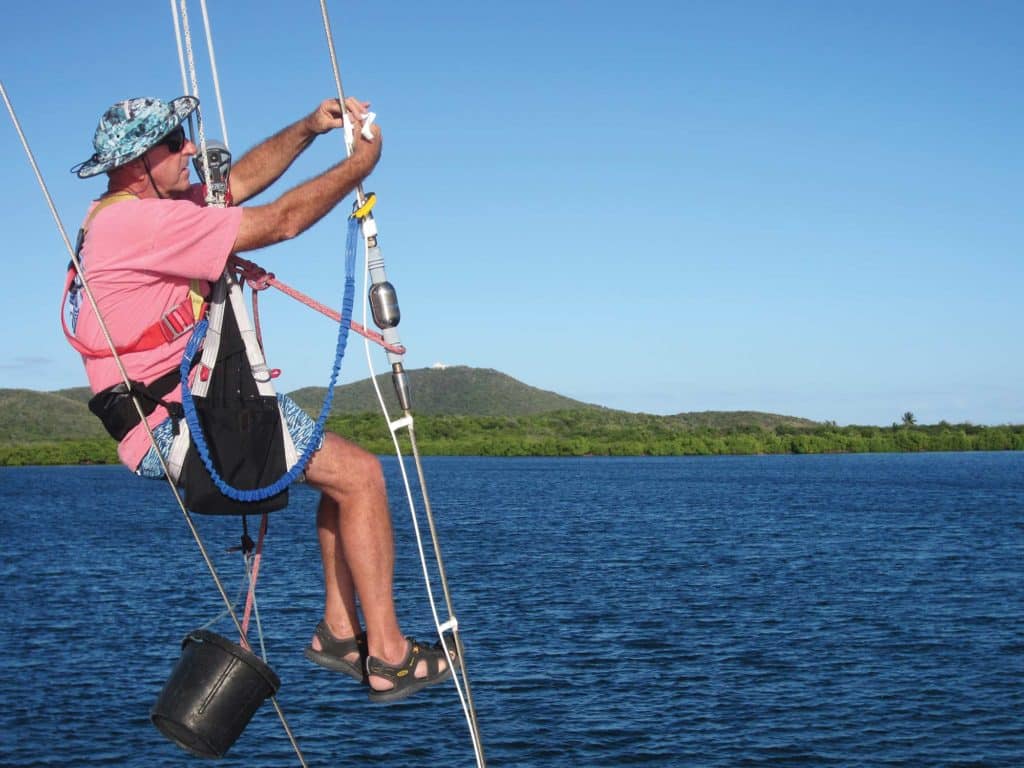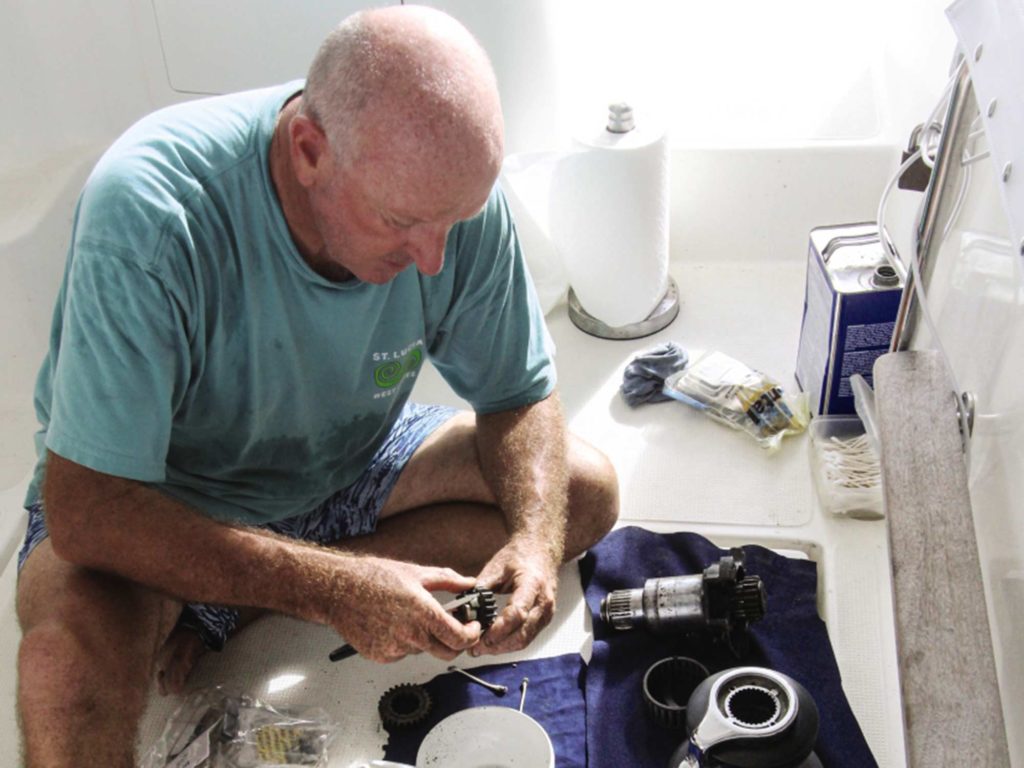
Now that you’ve made the switch to cruising on two hulls instead of one, you might hear occasional snark from your monohull ex-brethren. “A catamaran, huh? You’ve got two of everything. That’s twice the maintenance!”
Along with other monohull myths, that’s not quite true. Sure, we cat converts have double the most important safety features of a mono—two rudders and two engines, along with other virtues—but we do not have twice the annual maintenance, in terms of work and cost.
A cat’s annual maintenance load, apart from two engines, is about the same as a similar-size mono. Here’s what you can expect if you join the cat club, and how to handle common issues that might crop up.
Steering
Whether your steering system is chain-and-cable, Spectra line or hydraulic—as is the case with our Dolphin 460, Ocean—nothing is as disabling or dangerous as a loss of steering.
Does your cat’s steering feel too loose or too tight, at speed under sail or power? Give all the steering components a critical evaluation. Look for wear in the steering cables (either wire or Spectra) and sheaves. Enlist an expert, and look over his or her shoulder. Ask questions.
For hydraulic steering systems, is the feedback on the wheel spongy? If so, there might be an air bubble (or two) in the lines, the result of a fluid leak at one or more of the connection fittings. Check with your boatbuilder for the correct bleeding procedure. Bring aboard a hydraulics expert, and observe and ask questions.
If your cat’s rudders are out of parallel alignment, the cause (a hydraulic leak, a stretched or worn cable) needs to be chased down and corrected. Make sure that the emergency tiller can be used on either rudder, and that the other rudder (if it gets damaged, for instance) can be isolated from the system and allowed to free-float.
For example, on Ocean’s hydraulic steering, we can pop the emergency tiller onto the shaft of one rudder and throw an isolation valve for the opposite (damaged) rudder that allows the rudder to align itself with the flow of water past the hull.
Engines
Maintaining two engines is not—surprise, surprise—the highlight of a cat cruiser’s existence. But the “other engine” has come in mighty handy.
Once, while motoring up the leeward side of the island of St. Vincent in the eastern Caribbean, Ocean’s starboard engine overheated. The raw-water impeller had failed. We switched to the port engine and continued on our way. I was able to change the starboard engine’s impeller, and we were back to both engines in 20 minutes.
Another time, in Bermuda, the port engine’s starting battery suddenly died. By starting and revving up the starboard engine, we were able to jump-start the port engine—a good trick in a fix.
There is nothing special to maintaining a cat’s two diesel engines. Just like the diesel on a monohull, they need clean fuel (we change our filters every season, or after burning 100 gallons or so), a steady flow of cooling water (we install new impellers at the start of each season), proper coolant level (we top off as needed), and proper oil levels in the transmission or saildrive leg. To simplify maintenance intervals, most cat cruisers keep their port and starboard engine hours roughly the same. Keeping your engine room scrupulously clean is a good way to spot trouble (an oil or fuel dribble, rubber shavings from an errant drive belt, a seawater leak from a cracked hose) before it really is trouble.
Having two engines also gives you a valuable basis for comparison, and can buy you time. If one of your engines seems to be running hot or making a suspicious noise, then compare it with the other engine. If there is an issue, shut down the problem engine and run on the good one.
Most cats do fine on one engine—you won’t go as fast, but you’ll get there. One engine is enough to power your navigation and liveaboard systems, charge your batteries, and get you home without calling for help.
Rigging
Where a monohull’s low initial stability tends to absorb rig loads, a cat’s high initial stability results in sudden high loads on standing rigging components, from swages and mechanical fittings to cables and mast tangs.

Go aloft and inspect your cat’s standing rigging at least once a season. Look for popped strands, cracked swages, evidence of stretched tangs or worn clevis pins, or a suspicious increase in wear in the top swivel of the roller furler. On Ocean, I go aloft with a critical eye two weeks before an offshore passage. If I find trouble, this timing gives me a cushion to schedule a professional rigger and/or order a replacement component.
A cat’s high initial stability results in higher-than-monohull loads on sheets and control lines too. By now, 15 years and 46,000 miles into the ownership of Ocean, we’ve replaced all of our factory-standard polyester lines with high-strength Spectra-cored line. Be sure to give all your sail fastenings, whether metal shackles or Spectra lashings, a close look, and renew them if chafe or ultraviolet sunburn has made inroads.
While cats heel only a maximum of 4 degrees, the sudden, repetitive lateral movements of a cat, particularly in beam seas, is hard on the connections that secure your boat’s sails to spars, to standing rigging and to the boat.
Everything else
No one knows your boat like you do. You are the detective. The tip of the spear. Look for telltale cracks in old hoses; rusty, untrustworthy hose clamps (these days, globally sourced, substandard metal parts are everywhere); drips of rust, crusts of corrosion, cracks of consequence (with metal or fiberglass, how deep is the crack?); and unnerving new noises (has the windlass always made that groaning, growling sound?).
Some maintenance items, such as expiration dates on your EPIRBs and the health of your flashlight batteries, are simple to check. You just need to remember to do so.
Are your running lights, bilge pumps, winch pawls and propane stove up to speed? When did you last check all these items? They can creep up on you if you don’t make a list and keep it updated. A maintenance checklist sounds like something that a monohull sailor would suggest. But it’s a good idea for cat owners too.
At press time, Tom and Harriet Linskey were cruising the Marquesas aboard Ocean.
Deferred Maintenance: The Day I Declared Victory
Every time I have dallied with deferred maintenance, I’ve regretted it. That includes a situation to which I now refer as the Agony and Ecstasy of the Raw-Water Pumps.
About five years ago, at my request, a high-priced boatyard replaced Ocean’s raw-water pumps, which were leaking salt water. I didn’t know that the pump’s O-ring, which fits into a recess in the engine block, makes the pump diabolically tough to change.
The raw-water pump is located on the front of the engine, already a tough spot to access because of a nearby watertight bulkhead. When you place the O-ring into the recess, it falls out before you can tighten the four bolts of the pump housing. So, the engine mechanics, no strangers to shortcuts, substituted a flat ring in place of the official Volvo Penta O-ring.
All of this was unknown to me. The previous seawater leaks of the old raw-water pumps were halted, but two other leaks were born. The flat rings leaked. The oil drip escalated to a trickle, then to a stream. Would the pump erupt into an oil gusher? I didn’t know.
Months later, in Bermuda while en route to Antigua, I removed the raw-water pump and found those flat rings. Luckily, I had two of the official Volvo Penta raw-water pump O-rings, and I vowed to lie on top of the engine, with injector pipes punching into my rib cage, until the raw-water pumps were correctly installed.
Much as I tried, I could not do it. The O-rings fell out of their shallow recess every time. Then, the raw-water-pump gear got stuck halfway in, cockeyed with the engine gear. Very, very bad.
Somehow, I managed to wrestle the pump free from the engine innards. I then reinstalled the pump with the old, leaky flat ring—a soul-destroying defeat. But we voyaged on, both engines slowly streaming oil from their raw-water pumps, my usually spotless engine rooms a mess.
A year or two passed. I did not choose deferred maintenance; it had chosen me. Then, one evening, the solution came to me: Remove the pumps, clean the O-ring recess with an acetone-soaked cotton swab, and use a detail paintbrush to paint the engine recess and the O-ring with contact cement. Let it dry, press the O-ring into the groove, insert the bolts, and tighten.
It worked. No more oil leaks. A defeat for deferred maintenance. The satisfaction of victory runs deep. I sometimes scrunch myself into the engine compartment, my head inches from the watertight bulkhead and drive belts, just to watch my raw-water pumps whirring along, 100 percent leak-free.
They are so solid. They are inspiring. They are my babies. —TL








